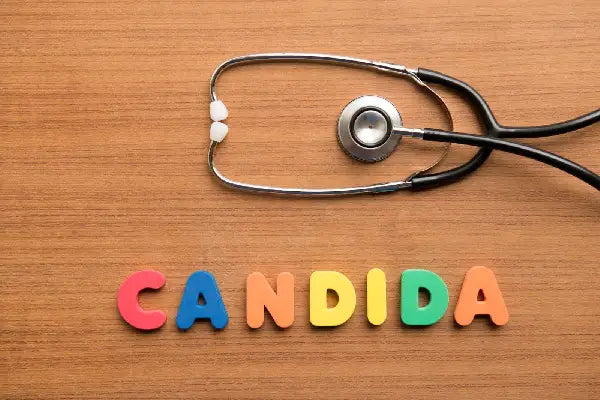
Select the option that best fits you.


Have you been battling candida overgrowth with no cure in sight? Desperate for a solution to this pesky problem without any of the annoying side effects?
You're in luck. This post will guide you on how to get rid of candida naturally and for good.
Candida is a yeast (a type of fungus) found in various areas throughout your body, such as your gut, skin, mouth, throat, and genitals. A staggering 97 percent of SIFO fungi stems from candida.
Small amounts of candida are good for you, as it helps with digestion, provides immune support, and enables your body to properly absorb vitamins and minerals, among other things. However, an abundance of candida can result in candida overgrowth and throw your body for a loop while causing some not-so-favorable symptoms.
There's not a fungal infection more common than candida overgrowth. For example, an overgrowth of candida in the vagina is referred to as a yeast infection, while candida overgrowth in the mouth is called thrush. Candida overgrowth can also occur in breastfeeding women and babies.
Here's a more detailed list of some symptoms that may indicate candida overgrowth:
Digestive issues: Symptoms of candida overgrowth in the gut may include problems like constipation, diarrhea, bloating, gas, and stomach pain. Gut-related disorders like ulcerative colitis and Crohn's disease have also been linked to candida overgrowth. Frequent vaginal yeast infections: Roughly 75 percent of women will experience a yeast infection in their lifetime. But if they become a recurring issue, it could point to candida overgrowth. Urinary tract infections (UTIs) may also indicate candida overgrowth. Shifts in your mood and mental health: This can include depression, anxiety, or brain fog. Skin issues such as acne or eczema: Did you know that skin issues start in the gut? Weakened immune system: Becoming sick easier and not being able to recover as fast. You may experience symptoms like chronic fatigue or sinus infections.
There are many factors that contribute to candida overgrowth but two of the biggest reasons are:
Antibiotics can't tell the difference between good bacteria and harmful bacteria. So while taking them removes bad bacteria from your gut, it also results in “friendly fire” and eliminates some of your gut's beneficial bacteria as well. This can open the door for candida to grow and populate, which ultimately leads to candida overgrowth.
To get rid of candida, it takes a two-pronged approach. The first step is removing or cutting back on foods in your diet that the yeast can use to grow and multiply, which include:
The second step to eliminating candida overgrowth and keeping it away for good is following a diet centered on nutritious foods to promote beneficial gut bacteria, bring balance back to your body, and prop up your immune system.
Candida diet food list:
Research shows probiotics to be an effective option for eliminating candida and preventing future episodes.
One 6-month study took a look at how probiotic supplements could help those with frequent vaginal yeast infections (i.e. candidiasis). The study separated participants into two groups—one group was given a probiotic supplement that contained multiple strains of lactobacillus and the other group was given a placebo.
Over the study's duration, only 7% of the probiotics group experienced another episode of candidiasis, compared to 36% of the placebo group.
Strains from the Lactobacilli family have proven to be particularly useful for combating candida and possess the greatest anti-fungal properties:
The length of time it takes to get rid of candida varies from person to person and will be influenced by a variety of different factors. Some people may notice relief within the first few weeks of making changes to their diet and lifestyle, while others (especially if they're immune-compromised), might take more time to eliminate candida completely.
But the good news is that by following a Candida diet that starves the yeast and is rich in probiotics to repopulate your gut with good bacteria to boost gut health, you can get rid of candida for good.
There are many gut health tests out there but the two common Candida tests include blood culture tests and stool tests.
With the Floré Personalized Probiotics Program, we can see the specific strains of candida in your stool and craft a custom probiotic tailored to your individual gut profile to help fight it off.
In small amounts, candida is okay. It provides balance to your gut and body, aiding in digestion and providing support to your immune system, among other things.
However, sometimes, an overgrowth of candida can occur and cause some pretty terrible symptoms, including digestive problems, recurring vaginal yeast infections for women, and skin issues like acne and eczema.
To get rid of Candida naturally and permanently, remove or significantly cut back on the following in your diet and lifestyle:
At the same time, follow a candida diet of the following foods to help repopulate your gut with good bacteria and bolster gut health:
About the Author
Chad Richardson is a freelance writer from Cincinnati, OH who also enjoys going to the gym and doing his best Arnold Schwarzenegger impersonation, scrolling through Netflix trying to find a new binge-worthy show, and catching a game to root on his hometown sports teams.
We can support you on the path to better wellness by providing you with the information you need to start the conversation, and we can provide tailored support for your provider.
